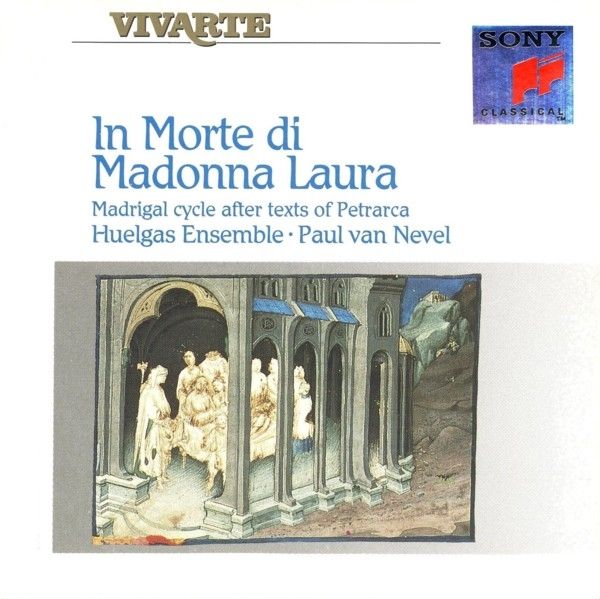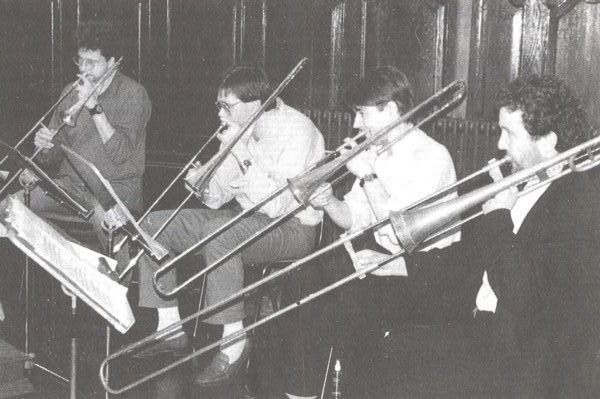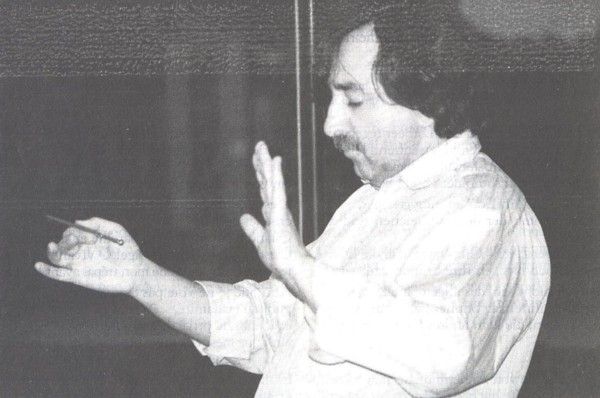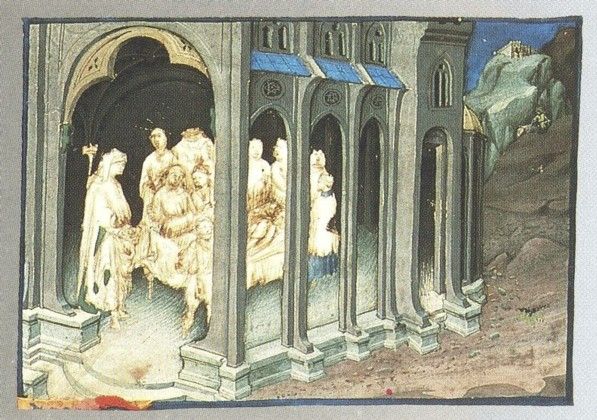In morte di Madonna Laura / Huelgas Ensemble
Madrigal cycle after texts of Petrarca

medieval.org
Sony Vivarte 45942
1991
1.
1 - [6:03]
1a. Canzoniere No.267
Spirito l'Hoste da REGGIO (c.1510-c.1575). Oimè il bel viso
1b. Canzoniere No. 283
Spirito l'Hoste da REGGIO. Discolorato hai, Morte, il più bel volto
2. Canzoniere No. 268
2a. [stanza 1 + 2]
2. Padre F. Mauro de'SERVI (c.1545-c.1621). Che debb'io far - Amor
tu'l senti [5:49]
2b. [stanza 1 + commiato]
3. Bernardo PISANO (1490-1548). Che debb'io far - Fuggi'l sereno
[4:39]
2c. [commiato]
4. Tomaso CIMELLO (c.1500-c.1580). Fuggi'l sereno [2:55]
3. Canzoniere No.353
5. Stefano ROSSETTI (c.1520-c.1585). Vago augelletto che cantando vai
[5:15]
4. Canzoniere No. 282
6. Baldassare DONATO (c.1530-1603). Alma felice che sovente torni
[5:41]
5. "Mia benigna fortuna" (Canzoniere No. 332)
5a. [stanza 2]
7 . Padre F. Mauro de'SERVI. Crudele, acerba, inexorabil Morte
[4:19]
5a. [stanza 10]
8. Cesare TUDINO (c.1530-c.1590). Amor, i'ho molti e molt'anni pianto
[5:07]
5a. [stanza 7]
9. Spirito l'Hoste da REGGIO. Nessun visse già mai
più di me lieto [7:00]
6. Canzoniere No. 365
6a
10. Padre F. Mauro de'SERVI. Io vo piangendo i miei passati tempi [4:58]
6b
11. Andrea ROTA (1553-1597). Io vo piangendo i miei passati tempi
[4:16]
7. Canzoniere No. 246
12. Nicola VICENTINO (1511-c.1576). L'aura che'l verde lauro
[6:12]
Huelgas Ensemble
Paul van Nevel
Katelijne van Laethem, Cantus
Ibo van Ingen, Tenorino
John Dudley, Tenor
Josep Cabré, Baritone
Lieven de Roo, Bass
Johannes Boer, Tenor Viola da gamba - R. Passaro, Belgium
(Italian Renaissance)
Gail Ann Schroeder, Bass Viola da gamba - M. Ternovec, Italy
(after Gasparo da Salò)
Piet Stryckers, Bass Viola da gamba - R. Passaro, Belgium
(Italian Renaissance)
Willem Bremer, Cornetto - J. van der Veen
Bass Curtal - Eric A. Moulder
Recorder, Bass Recorder - E. G. Morgan/Hopf
Bart Coen, Alto and Basso Recorders - Koblicheck, Bergström
René van Laken - Tenor Curtal - Eric Moulder, London 1984
Harry Ries - Alto Saqueboute - H. Glasl, 1989
Wim Becu - Bass Saqueboute - Meinl & Lauber, 1978
Producer / Recording Supervision: Wolf Erichson
Recording Engineer / Editing: Stephan Schellmann (Tritonus)
Recording place: Chapel of the Paridaens Intituut, Leuven (Belgium)
February 23-25, 1990
Cover Design: CC. Garbers / B. Kruck
Cover Front: Book Miniature from Petrarca's 264th Chant (Bologna),
Archiv für Kunst und Geschichte, Berlin
℗ Sony Classical GmbH
© Sony Classical GmbH

PETRARCA AND HIS
CANZONIERE
Francesco Petrarca (1304-1374), one of the greatest
poets and Humanists that Italy has ever produced, was, to say the
least, a most controversial figure. He was a Humanist, poet, diplomatic
emissary, great traveller, author of pamphlets, translator, lively
letter-writer and a person with a critical eye for the ins and outs of
society.
Petrarca's activities in life centered around three
geographical areas. The first of these was Avignon, a city he
frequently visited. He was especially drawn to Fontaine de Vaucluse, a
village nearby, where he spent long periods meditating, writing and
working on new projects. The second pole to which Petrarca felt
attracted was the city of Rome, which he visited for the first time in
1337. Petrarca was to regard the eternal city as the center of Western
society for the rest of his life. The third area where Petrarca spent a
great deal of time was northern Italy, where he travelled through or
stayed in cities such as Verona, Bologna, Venice, Padua, Parma and in
particular, Milan, where he was associated with the court of Galeazzo
Visconti.
But of course Petrarca also travelled outside of
these areas as well; in 1333 he travelled to Paris, Gent, Cologne and
Liège, where he is said to have re-discovered the speeches of
Cicero. In 1343 we find Francesco in Naples, on a diplomatic mission;
in 1355 he visited Paris and in 1356, Prague.
The vast majority of his œuvre is written in
Latin. Petrarca thought in Latin; it was his "working language".
Petrarca's most important contribution to Italian poetry is his
collection of poems known as the Canzoniere. This collection
made him more famous than all his Latin works combined. The Canzoniere
originated due to an event which affected him emotionally for the rest
of his life. It was his fleeting acquaintance with a beautiful woman,
Laura de Noves, whom he met on the 6th of April, 1327 in the Church of
St. Claire in Avignon. This meeting was to play a crucial role in
Petrarca's life, both as a poet and as an artist. His - under the
circumstances - platonic love for Laura finds its expression in the
poetry of the Canzoniere. His lovesick state is incurable and
his feelings received a new impulse in 1349, when he heard of Laura's
death. He then began to give the poems he had already written a more
definite structure, augmenting these with new poems and giving the Canzoniere
its present organization. In 1367, he gave the collection the
definitive title of Rerum Vulgarium Fragmenta. The Italian
madrigalists of the sixteenth century regarded these verses to be the
most exemplary form of Italian poetry ever created.
The Canzoniere collection consists of 366
poems Petrarca wrote from 1327 onwards and is divided into two parts:
the first part, In Vita di Madonna Laura, contains 263 poems
and was written before Laura's death; the second part, In Morte di
Madonna Laura, contains 103 poems, all dedicated to Francesco's
mourning and to the memory of Laura. It is typical of Petrarca that he
writes as much about himself as he does about his lost love. In many of
his poems, Petrarca opens up his soul to the reader, making masterly
analyses of his inner life and of his doubts. In Morte di Madonna
Laura depicts countless shades of the emotions of one man, from
sublime memories to inconsolable despair. A kind of musical fluidity
arises from Petrarca's careful and flexible use of elisions, and
through the almost inexhaustible richness of his metrical
constructions. His style is characterized by an abundant use of
rhetorical figures; the antithesis in particular can be considered the
hallmark of Petrarca's language.
Its richness of sound and rhythmic virtuosity,
coupled with its luxuriant imagery must have made Petrarca's work
appealing to the Italian madrigalists of the sixteenth century.
Petrarca, who himself sang and played a plucked instrument, clearly had
no high opinion of Italian minstrels. In a letter to his friend
Boccaccio, he wrote that Italian musicians possessed "no great voices,
but long memories, great diligence and even greater shamelessness".
In the sixteenth century, a great interest in
Petrarca's poetry arose; no composer failed to set his texts to music:
All the poems contained in the Canzoniere were set to music at
least once, more often by various composers in several versions. Two
reasons can be given for this sixteenth century "fashion": first,
Humanism was attaining growing importance and this led to a demand for
good texts, especially in the composition of madrigals - composers
found in Petrarca's poetry just the emotional tone and rhythmical
variety they were seeking for these works. Second, the rise of
Petrarchism in the sixteenth century also contributed to an increasing
interest in his works in musical circles. The foremost supporter of
Petrarca was Pietro Bembo (1470-1547) who termed Petrarca's Canzoniere
an exemplary work for all Italians in his "Prose della volgar lingua",
declaring Tuscan to be the superior Italian language. Bembo published
the Canzoniere in 1501; in the course of the sixteenth century,
more than 130 editions of this work appeared in Italy.
It is against this background that we would like to
place the "musical Petrarchism" evidenced in the works of the best
Italian composers of Petrarca's texts. In the case of the sometimes
little-known Italian composers we have chosen for this recording, their
rendering of the expressive and emotional content of Petrarca's texts
makes them the (unrecognized) leaders in expressing Petrarch's art.
Paul van Nevel

Spirito l'Hoste da Reggio (c. 1510-c. 1575; period of artistic
activity: 1545-1560), born in Flanders, went to Italy, as did many of
his countrymen, due to the greater possibilities Italy offered in terms
of artistic fulfillment as a composer. The first madrigal on this
recording, with its repeated motive of lament in the upper voice, was
drawn from his first volume of madrigals, published in 1547.
Padre F. Mauro de'Servi (c. 15451621), like his contemporary
Andrea Rota (1553-1597), was active in Bologna. The compositions he
wrote there not only demonstrate the conventional compositional
rendering of the text typical of his day (that is, madrigalisms) but
also reveal Servi's attempts to convey even subtle nuances in the
poetic language.
Stefano Rossetti (c. 1520-c. 1585; period of artistic activity:
1560-1580), active at the Cathedral of Florence about mid-century, is
considered the originator of the "madrigale arioso": the texts of his
compositions are not interpreted musically so much by harmonic means as
by a very vivid rendering using elaborate embellishments in the vocal
line.
Bernardo Pisano (1490-1548), the oldest composer in this cycle,
writes in a contrapuntally stricter style than the others. The
sometimes surprising cadential formulas of this composer, who was also
a singer at the papal chapel in Rome, foreshadow the bold harmonic
practices of the later, "true" madrigalists.
Tomaso Cimello (c. 1500-post 1579) treats text and music in his
madrigals as elements of nearly equal importance: not only does he
carefully note the author of each text, but he also takes individual
lines of the poems of several authors as the basis for some of his
compositions. In this recording, however, one gains the impression that
the text is more important than the music.
Baldassare Donato (between 1525 and 1530-1603) was the court
music director at the Cathedral of St. Mark in Venice from 1562 to
1565. The counterpoint and pleasing sonoric quality of his compositions
reveal quite clearly the influence of his contemporaries and friends
Adrian Willaert and Cipriano de Rore.
Cesare Tudino (c. 1530-c. 1590) is represented on this recording
by a madrigal taken from his first volume of madrigals, published in
1554. The bold chromaticism and the daring treatment of dissonances in
this work reveal him as a very progressive composer of this period.
Nicola Vicentino (1511-1576) caused a great sensation among his
contemporaries through his attempts to explore extensively the harmonic
possibilities of the tonal system of his day, creating amazing sonoric
effects in his music. His innovations in the compositional sphere,
however, in no way affect the form and construction of the texts he set
to music, in this case a poem by Petrarca.
Translation: Deborah Hochgesang




